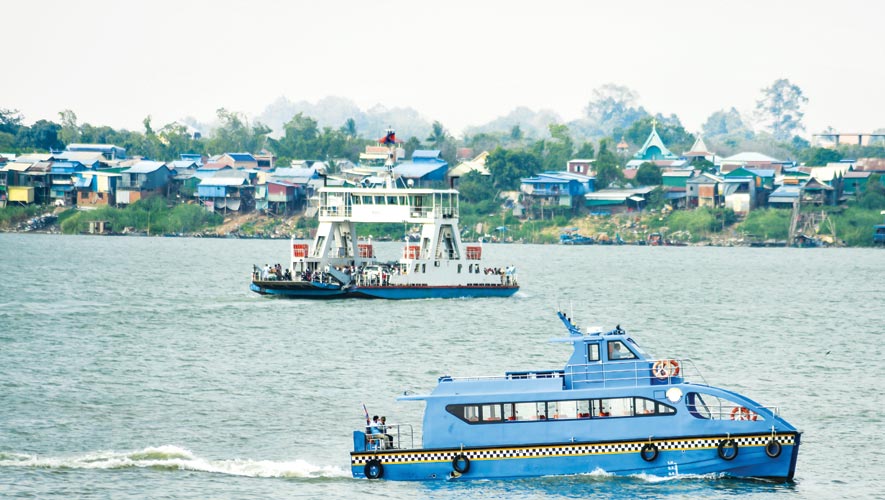The capital has a comprehensive transport masterplan with a railway system aimed at reducing massive jams
For the latest Cambodian Business news, visit Khmer Times Business
In the last 10 years, rapid change has swept through Phnom Penh on the back of improved economic activity and population growth. Data from the preliminary 2019 census shows that the number of people in the capital city grew to 2.13 million as of March 20 this year compared with 1.5 million people in 2008. Based on the calculation, the National Institute of Statistics noted that the city’s population has been rising at a compound annual growth rate of 3.2 percent between 2008 and 2019. In tandem with the growth, vehicle registrations in the city rose 31.26 percent to 579,896 in 2018 from 441,800 a year ago, driven by increased incomes and cheaper imported vehicles. Although the growth is positive for the economy, it has created an unfortunate impact on the city, choked by daily traffic congestion, no thanks to narrow roads and the invasion of ride-hailing apps.
A study by Japan International Cooperation Agency (JICA) which developed the Urban Transport Masterplan (2014-2035), suggests the implementation of a collective and comprehensive public transport system for Phnom Penh.
“To successfully introduce a mass transit system, it is essential to divert trips from private vehicle users to a public transport system. This may be done by keeping the competitiveness of a mass transit system with a conventional road transport mode,” the report states.
The implementation of the short- to mid-term plan is estimated at $1.16 billion.
‘Forced to travel’
In the case of motorcycle users, many of them have to travel more than 20km each trip. From the viewpoint of safety and comfort, the travel distance by motorbikes is below the standard of accessibility of suitable transport.
Therefore, introducing a convenient and comfortable public transport mode including improving the bus system becomes essential to those who do not have any means of transport.
Even with the city bus system operating in 13 routes in Phnom Penh, and except for the availability of para-transit such as Motodop and tuktuk, there is no convenient and comfortable public transport mode in the city.
The inter-city buses and their terminals are all located in the city centre.
Buses are forced to travel on the narrow and congested city centre streets. Also, their depots are often too small and there is no space for any expansion, making it necessary to plan for a national road network system that links all the gateways to all the cities.
To this end, there is a need to relocate such bus terminals to the suburban areas. There are several ferry transport services in the city.
However, access to passenger jetties is chiefly by motorcycle, which is rather inefficient. For this reason, the public transport system should provide direct linkages to these ferry jetties.
Air and noise pollution
Given the future growth of passengers (especially from the rapid increases in group tours), it is pertinent to start preparing a public transport system that can provide efficient access to the airport with large travel capacity.
“The shortage of a public transport service remains a challenge for Phnom Penh. The current city bus service has yet to respond to the rising demand of public transport services. The services are in need of expansion and under effective management and operation,” says JICA.
The absence of a reliable public transport service is also one of the main drivers of rising private usage. In 2018, motorcycle registrations made up 68 percent of the total figure with some 73,509 cars recorded in the same period. As of Feb 11 this year, the authority recorded 36,804 vehicle registrations.
Phnom Penh is a medium-sized city with historically developed structures with low road capacity and spacial constraints. The agency finds that cars are a system that broadly occupies urban roads which are seen as the most precious urban spaces.
“They emit exhaust gas and cause noise pollution to the surrounding area. Driving cars is also not an energy-efficient option,” the report says. Having to cope with a modal shift and encourage mode change from car trips, it then becomes necessary for Phnom Penh to introduce a collective public transport system.
To successfully introduce a mass transit system, JICA says it is essential to encourage private vehicle users to use the public transport system. This could be done by balancing the competitiveness of a mass transit system with a conventional road transport mode.
Master-planning the city
In 2014, Phnom Penh Capital Administration, with the assistance of JICA, developed the masterplan to solve the worsening traffic condition. It was also drawn up in support of the 2035 Urban Vision under the Phnom Penh Master Plan for Land Use 2035.
JICA’s masterplan reveals that the current provision of transport infrastructure has not kept pace with the rapid traffic expansion. Compared with other cities in the region, Phnom Penh has a low road density, particularly outside the city centre.
“There are several challenges identified with Phnom Penh’s traffic management – problematic intersections, inadequate travel signage systems, a lack of road markings and uncontrolled parking,” JICA says.The inadequate parking spaces in the city centre is also a critical issue, resulting in drivers parking by the road or on sidewalks.
“Phnom Penh’s pedestrian sidewalks are disappearing due to the widening of roads in favour of cars. Enforcement of parking regulations is also a major issue,” it says.
The masterplan recommends a shift to a balanced system of public and private transportation, road system and traffic management to improve people’s mobility. It aims to create a people-friendly environment and revitalise urban activities in Phnom Penh.
It also seeks to increase the use of public transport to more than 30 percent of the modal share by 2035. This would be achieved by introducing (among other measures) 10 bus routes by 2020 as part of a bus rapid transit scheme and a partially underground elevated rail transit system by 2035.
Rail study by China
Public Works and Transport Ministry spokesman Va Sim Sorya says that China has been requested to study the probability of building a monorail, metro or sky train to reduce traffic congestions in Phnom Penh.
“JICA’s Automated Guideway Transit (AGT), which is included in its Urban Transport Masterplan 2035 will be submitted to the Economy and Finance Ministry. It will have to look at the cost of implementation,” he says.
UN Development Program me (UNDP) Cambodia resident representative Nick Beresford says the capital has taken significant measures to establish the public transport system. There are more than 10 public bus lines in Phnom Penh but there has to be more focus on traffic congestion, road safety, air pollution and greenhouse gas emissions.
“Other countries within the region also face similar challenges but it has given us great opportunities to learn within the region,” Beresford says.
The public transport masterplan is a positive move to ensure that Cambodians benefit from an affordable and convenient system.
“Helping traffic flow smoothly while enabling cleaner fuel vehicles, such as liquid petroleum gas and electric vehicles, and actions by the National Road Safety Committee (NRSC) are existing ways to address this issue,” he adds.
UNDP and Grab
Last year, UNDP launched a programme called Sustainable Urban Mobility for All Initiative (SUMAI) with ride-hailing app Grab.
It was in support of the road safety and cleaner transport work by the Public Works and Transport Ministry, and Environment Ministry.
“Under the SUMAI project, UNDP and its project partners, are conducting a research study on the socio-economic cost of public transport in Cambodia that will be presented by the end of this year.
“This study examines the cost of road congestion and accidents. It will also support the government on policy recommendations,” Beresford adds.




